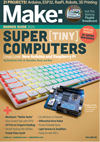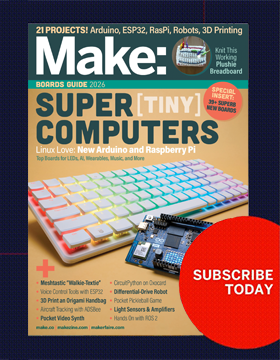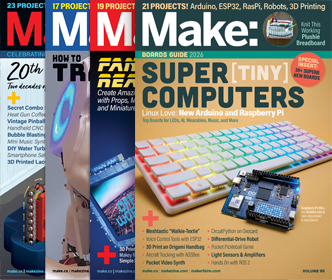
Laser Cut Dinosaur Safety Gear Holders
45-60 min
Ages 11-18
What Will You Learn?
This project tutorial will show you how to make dinosaur safety gear racks for storing and displaying your earmuffs and safety glasses. They can be mounted on any wall and provide a stylish and novel way to store your safety gear! There are four different dinosaurs available for download: tyrannosaurus rex, velociraptor, brontosaurus, and triceratops. You can make as many of these “T-racks” as you need (haha, get it?), and can easily add extra heads to your workshop walls as you acquire more safety gear.
These dinosaurs are laser cut from acrylic sheets and then glued together with acrylic cement. ⅛“ acrylic was used because it comes in many pretty colors and is also cheaper than thicker acrylic. Translucent acrylic was used in this post, but opaque colors can be used too.
The vector files are designed for ⅛“ acrylic, but you can easily use different thicknesses of plastic, you’ll just have to alter the illustrator files slightly. The width of the slot in the mounting plate will need to be changed, and so will the width of the interfacing notches in the bar for the safety glasses. Laser cutters typically have a 0.008” kerf (the kerf is the amount of material removed by the laser), so take this into account when tweaking the files to ensure a tight fit.
Note: Initially, the bar for the safety glasses was just a thin metal rod press-fit into a hole in the dinosaur’s head, but an acrylic version was added into each vector file to nicely package all the required parts on one sheet of material. However, if you like the look of the metal rod better, then all you have to do is drill a small hole in front of the notch in the dinosaur’s head, and slide in a 6” chunk of the rod.

Make Your Dinosaur Racks
Step 1: Download the files
Download the vector files using the link. The Illustrator files and a .dxf version are both included. Each file has a dino head, a mounting plate, and a bar to hold the safety glasses.

Step 2: Cut the Acrylic
The files are designed for ⅛” acrylic (which I’ve found to be closer to 0.116″). If you plan on using a different thickness, you’ll have to tweak the files a bit so that the various slots are wide enough.
Cut the acrylic on a laser cutter. Double-check that you’ve got all the settings right!
I like to leave the paper backing on the acrylic and peal it off after the cut.

Step #3: Assemble
Glue the dinosaur head to the mounting plate.
Optional: Glue the safety-glasses-bar to the head.

Step #4: Mount the Heads
Screw the mounting plate to the wall; take care to not tighten the screws too much as the acrylic is prone to cracking.
You may need to use drywall anchors.

Step #5: Hang your safety gear
Hang your earmuffs and safety glasses as shown in the photo!

About the Magazine
Check out our collection of current and past issues of Make: magazine, rich with new ideas for projects, technology, and DIY articles, this magazine is not to be missed! Or subscribe today to get all the new issues!

This article was originally posted on Make: on July 30, 2015 by Sam DeRose.
PARTS
- ⅛" acrylic, 1'x1' sheet
- Mounting screws (4)
TOOLS
- Laser cutter
- Acrylic glue
- Screwdriver or drill
See More Projects in these topics:
Arts & Crafts Engineering FabricationSee More Projects from these themes:
Art/Craft Studio The Shop (Makerspace)Maker Camp
Maker Camp Project Standards
Based on NGSS (Next Generation Science Standards)
National Core Arts Standards
The National Core Arts Standards are a process that guides educators in providing a unified quality arts education for students in Pre-K through high school. These standards provide goals for Dance, Media Arts, Music, Theatre, and Visual Arts with cross-cutting anchors in Creating, Performing, Responding, and Connecting through art. The Anchor Standards include:- Generate and conceptualize artistic ideas and work.
- Organize and develop artistic ideas and work.
- Refine and complete artistic work.
- Select, analyze, and interpret artistic work for presentation.
- Develop and refine artistic techniques and work for presentation.
- Convey meaning through the presentation of artistic work.
- Perceive and analyze artistic work.
- Interpret intent and meaning in artistic work.
- Apply criteria to evaluate artistic work.
- Synthesize and relate knowledge and personal experiences to make art.
- Relate artistic ideas and works with societal, cultural, and historical context to deepen understanding.
CCSS (Common Core State Standards)
The Common Core is a set of high-quality academic standards in mathematics and English language arts/literacy (ELA).Measurement & Data
- Grades K-2
- CCSS.MATH.CONTENT.K.MD.A.1 Describe measurable attributes of objects, such as length or weight. Describe several measurable attributes of a single object.
- CCSS.MATH.CONTENT.1.MD.A.1 Order three objects by length; compare the lengths of two objects indirectly by using a third object.
- CCSS.MATH.CONTENT.1.MD.A.2 Express the length of an object as a whole number of length units, by laying multiple copies of a shorter object (the length unit) end to end; understand that the length measurement of an object is the number of same-size length units that span it with no gaps or overlaps.
- CCSS.MATH.CONTENT.2.MD.A.1 Measure the length of an object by selecting and using appropriate tools such as rulers, yardsticks, meter sticks, and measuring tapes.
- CCSS.MATH.CONTENT.2.MD.A.2 Measure the length of an object twice, using length units of different lengths for the two measurements; describe how the two measurements relate to the size of the unit chosen.
- CCSS.MATH.CONTENT.2.MD.A.3 Estimate lengths using units of inches, feet, centimeters, and meters.
- CCSS.MATH.CONTENT.2.MD.A.4 Measure to determine how much longer one object is than another, expressing the length difference in terms of a standard length unit.
- Grades 3-5
- CCSS.MATH.CONTENT.3.MD.B.3 Draw a scaled picture graph and a scaled bar graph to represent a data set with several categories. Solve one- and two-step "how many more" and "how many less" problems using information presented in scaled bar graphs.
- CCSS.MATH.CONTENT.4.MD.A.1 Know relative sizes of measurement units within one system of units including km, m, cm; kg, g; lb, oz.; l, ml; hr, min, sec. Within a single system of measurement, express measurements in a larger unit in terms of a smaller unit.
- CCSS.MATH.CONTENT.4.MD.C.5 Recognize angles as geometric shapes that are formed wherever two rays share a common endpoint, and understand concepts of angle measurement.
- CCSS.MATH.CONTENT.5.MD.A.1 Convert among different-sized standard measurement units within a given measurement system (e.g., convert 5 cm to 0.05 m), and use these conversions in solving multi-step, real world problems.
- CCSS.MATH.CONTENT.5.MD.C.3 Recognize volume as an attribute of solid figures and understand concepts of volume measurement.
Ratios & Proportional Relationships
- Middle School
- CCSS.MATH.CONTENT.6.RP.A.1 Understand the concept of a ratio and use ratio language to describe a ratio relationship between two quantities.
- CCSS.MATH.CONTENT.6.RP.A.3 Use ratio and rate reasoning to solve real-world and mathematical problems, e.g., by reasoning about tables of equivalent ratios, tape diagrams, double number line diagrams, or equations.
- CCSS.MATH.CONTENT.7.RP.A.1 Compute unit rates associated with ratios of fractions, including ratios of lengths, areas and other quantities measured in like or different units.
- CCSS.MATH.CONTENT.7.RP.A.2 Recognize and represent proportional relationships between quantities.
CCSS (Common Core State Standards)
The Common Core is a set of high-quality academic standards in mathematics and English language arts/literacy (ELA).Geometry
- Grades K-2
- CCSS.MATH.CONTENT.K.G.A.1 Describe objects in the environment using names of shapes, and describe the relative positions of these objects using terms such as above, below, beside, in front of, behind, and next to.
- CCSS.MATH.CONTENT.K.G.A.2 Correctly name shapes regardless of their orientations or overall size.
- CCSS.MATH.CONTENT.K.G.A.3 Identify shapes as two-dimensional (lying in a plane, "flat") or three-dimensional ("solid").
- CCSS.MATH.CONTENT.K.G.B.5 Model shapes in the world by building shapes from components (e.g., sticks and clay balls) and drawing shapes.
- CCSS.MATH.CONTENT.K.G.B.6 Compose simple shapes to form larger shapes.
- CCSS.MATH.CONTENT.1.G.A.1 Distinguish between defining attributes (e.g., triangles are closed and three-sided) versus non-defining attributes (e.g., color, orientation, overall size); build and draw shapes to possess defining attributes.
- CCSS.MATH.CONTENT.1.G.A.2 Compose two-dimensional shapes (rectangles, squares, trapezoids, triangles, half-circles, and quarter-circles) or three-dimensional shapes (cubes, right rectangular prisms, right circular cones, and right circular cylinders) to create a composite shape, and compose new shapes from the composite shape.
- Grades 3-5
- CCSS.MATH.CONTENT.4.G.A.3 Recognize a line of symmetry for a two-dimensional figure as a line across the figure such that the figure can be folded along the line into matching parts. Identify line-symmetric figures and draw lines of symmetry.
- Middle School
- CCSS.MATH.CONTENT.6.G.A.4 Represent three-dimensional figures using nets made up of rectangles and triangles, and use the nets to find the surface area of these figures. Apply these techniques in the context of solving real-world and mathematical problems.
- CCSS.MATH.CONTENT.7.G.A.1 Solve problems involving scale drawings of geometric figures, including computing actual lengths and areas from a scale drawing and reproducing a scale drawing at a different scale.
- CCSS.MATH.CONTENT.7.G.A.2 Draw (freehand, with ruler and protractor, and with technology) geometric shapes with given conditions. Focus on constructing triangles from three measures of angles or sides, noticing when the conditions determine a unique triangle, more than one triangle, or no triangle.
- CCSS.MATH.CONTENT.7.G.A.3 Describe the two-dimensional figures that result from slicing three-dimensional figures, as in plane sections of right rectangular prisms and right rectangular pyramids.
- CCSS.MATH.CONTENT.8.G.A.1 Verify experimentally the properties of rotations, reflections, and translations.
- CCSS.MATH.CONTENT.8.G.A.3 Describe the effect of dilations, translations, rotations, and reflections on two-dimensional figures using coordinates.
- CCSS.MATH.CONTENT.8.G.A.4 Understand that a two-dimensional figure is similar to another if the second can be obtained from the first by a sequence of rotations, reflections, translations, and dilations; given two similar two-dimensional figures, describe a sequence that exhibits the similarity between them.
NGSS MS.Engineering Design
The Next Generation Science Standards (NGSS) are K–12 science content standards.- MS-ETS1-1. Define the criteria and constraints of a design problem with sufficient precision to ensure a successful solution, taking into account relevant scientific principles and potential impacts on people and the natural environment that may limit possible solutions.
- MS-ETS1-2. Evaluate competing design solutions using a systematic process to determine how well they meet the criteria and constraints of the problem.
- MS-ETS1-3. Analyze data from tests to determine similarities and differences among several design solutions to identify the best characteristics of each that can be combined into a new solution to better meet the criteria for success.
- MS-ETS1-4. Develop a model to generate data for iterative testing and modification of a proposed object, tool, or process such that an optimal design can be achieved.
NGSS HS.Engineering Design
The Next Generation Science Standards (NGSS) are K–12 science content standards.- HS-ETS1-1. Analyze a major global challenge to specify qualitative and quantitative criteria and constraints for solutions that account for societal needs and wants.
- HS-ETS1-2. Design a solution to a complex real-world problem by breaking it down into smaller, more manageable problems that can be solved through engineering.
- HS-ETS1-3. Evaluate a solution to a complex real-world problem based on prioritized criteria and trade-offs that account for a range of constraints, including cost, safety, reliability, and aesthetics as well as possible social, cultural, and environmental impacts.
- HS-ETS1-4. Use a computer simulation to model the impact of proposed solutions to a complex real-world problem with numerous criteria and constraints on interactions within and between systems relevant to the problem.



